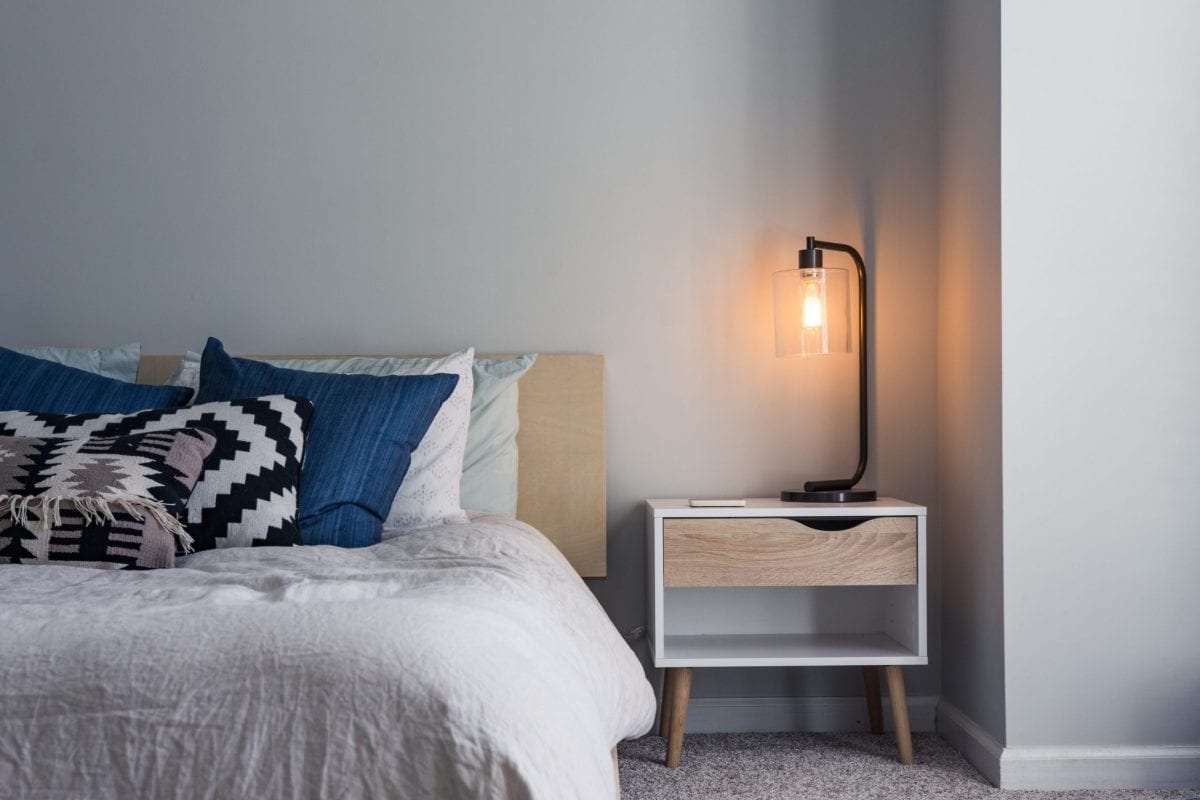Creating the perfect sleep environment is vital to improving your quality of sleep, and in turn, your quality of life. Having a calming sleep oasis will help to soothe both the mind and body before bed and help you wake up gently and peacefully in the morning.
Getting enough quality sleep is essential to everyday functions. By curating an ideal sleep environment, you can increase your productivity and physical performance. Though a bedroom remodel can get costly, depending on which improvements you need, having the perfect place to rest your head is well worth the investment.
Visual Design
The way your bedroom looks plays a large role in your sense of peace. Your room should be not only ultra-comfortable, but it should also evoke emotions of happiness and contentment and. You can achieve this through layout, organization, and decoration.
Features and Layout
- Avoid a cramped feeling by selecting and arranging furniture in a way that fits comfortably without being too snug.
- Freeing up floor space with creative storage ideas can help your bedroom look and feel calmer. Use the vertical space and under your bed to create storage space and make the most of your area.
- Focus on making your bedroom a room of rest and reserve work and even entertainment for other areas of your living space. Fight the urge to have a TV in your bedroom, as it will tempt you to watch before bed, throwing off your circadian rhythm.
- Unless absolutely necessary, don’t set up your work desk in your bedroom. The physical proximity of work can induce stress, making it difficult to fall asleep at night.
Organization and Decoration
- If you have the budget, choose a new color scheme for your walls, floors, and furniture. In general, soft, warm colors and neutrals work best in the bedroom, but you can choose something that works for you and resonates with your style.
- Avoid mess and clutter. Visual clutter can generate feelings of stress or anxiety, which are detrimental to sleep quality. Clutter serves as a physical reminder of incomplete tasks or unfinished business.
- Organize your belongings, such as clothes, in a manner that allows for a nice flow. Have clear pathways throughout the room and keep designated storage spaces for extra items.
- Consider adding photos of loved ones or decorating with items that make you happy. Doing so will make the area feel homey and cozy.
Practical Design and Other Elements
Your bedroom should also appeal to all your senses. The room’s design should be appealing and practical, and it should encourage relaxation and sleep.
Noise
- Noises can keep you up all night. Reducing or eliminating unwanted noise allows for a more comfortable, restful night’s sleep. You can do so by moving any electronics or gadgets that make noise from your room. If you can’t escape the noise—for example, if you live on a busy city street—try blocking it out with a white noise machine. These machines produce soothing, mellow sounds that can drown out external noises and help you fall asleep. There are also apps and podcasts available that can generate white noise.
- An alternative to white noise is relaxing music, which can encourage calm and promote better sleep. You can also set a timer to turn off the music in an hour once you’re (hopefully) asleep.
Lighting
- Light is an essential cue for your circadian rhythm, your body’s natural sleep clock. Having a dark room at night is essential in signaling to your mind and body that it is time for sleep. If you cannot keep your room dark because of bright outside lighting, consider using blackout curtains.
- As previously mentioned, don’t have a TV or other blue light-emitting devices in your bedroom. The blue light can disrupt your circadian rhythm and stimulate your brain, making it hard for you to fall asleep.
Smell
Certain odors can help foster a sense of calm and encourage better sleep. You can try aromatherapy essential oils like lavender, which can promote sleep. Essential oils are a quick, affordable option that can be used with a diffuser to fill your room with relaxing, sleep-supporting aromas.
Temperature
Your body needs to cool down to fall asleep. If your room is either too hot or too cold, you will likely encounter sleep issues. The ideal ambient temperature for best sleep is around 65 degrees Fahrenheit.
Air Quality
- Proper ventilation and fresher air are associated with better sleep. Sleep quality can be affected by mold and dust mites present in the air. Reducing excess humidity and ventilating your room can impede mold growth, while regular cleaning of surfaces can significantly decrease dust mites.
- Many houseplants act as natural air purifiers and can help to cleanse your bedroom’s air. You can also buy an air purifier, but keep in mind—the quieter, the better.
Mattress
- Your mattress is the foundation of your sleep setup. Having a well-built, comfortable mattress is essential to getting the best sleep possible.
- New mattresses can improve your sleep by giving your bones and joints proper support, regulating temperature, and providing comfort. You can click here to read Nolah Mattress reviews and see how much a new mattress can improve your sleep.
- The sheets and blankets you choose will add to your bedroom’s ambiance, so pick something that will put you in a cozy, relaxed mood.
- Add pillows to your bedding to make it more comfortable and to provide additional neck and back support while you sleep.
Transformative Changes
You’ll spend roughly one-third of your life sleeping, so it’s worth it to create a bedroom that relaxes you and supports rest and restoration. Even if you don’t have the time or resources to make all of the changes described above, making just a few modifications can go a long way to improve your bedroom ambiance and sleep quality.









